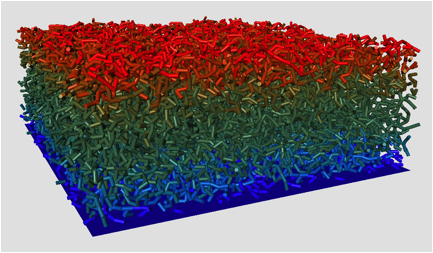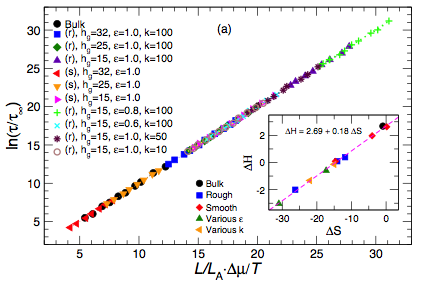Reports: ND751983-ND7: Dynamics of Ultra-Thin Polymer Films
Francis W. Starr, PhD, MA, BS, Wesleyan University
Impact of the Research
In the past year, this grant supported three published works. We briefly describe the key findings of these publications below.
Figure 1: Visualization of the polymer film relaxation gradient. The tubes represent the segments of the simulated polymer film supported on a rough substrate. The color gradient describes the local relaxation time as a function of distance from the substrate; the slowest relaxing chains are colored blue, while the most rapidly relaxing chains are shown in red. This illustration makes visually apparent the existence of a substrate, central and free-surface region of the film.
In [Nature Communications 5, 4163 (2014)], we examined the nature of interfacial dynamics and collective rearrangement within polymer films supported on substrates with variable interaction strength and rigidity. Our findings demonstrated that the size of string-like particle displacements quantitatively captures the changes to the overall relaxation of films, in the context of the Adam-Gibbs and random first-order transition descriptions of glass formation. Since this scale is not readily measured experimentally, we investigate the relation between the size of these "strings" and the scale of enhanced dynamics near the free surface of the film, which is experimentally accessible. We found a direct proportionality between these measures, offering a promising route to experimentally determine the scale of cooperative motion, and predict changes to film properties based only on interfacial measurements. These results drew heavily on our recent study [J. Chem. Phys. 137, 244901 (2012)], which was supported by the previous year's funding.
Figure 2: Test of the Adam-Gibbs relation using string size L. The data show that, regardless of film thickness or surface properties, all the data collapse to a universal description when parameterized by the scale L of cooperative monomer rearrangements. The inset shows the proportionality between enthalpy and entropy of activation for these rearrangements, defining an entropy–enthalpy compensation temperature Tcomp.
In [J. Chem. Phys. 140, 204509 (2014)], we aimed to provide a more fundamental and quantitative approach to predict the size of the string-like rearrangements identified in the previously discussed work. This description could be used as input for the Adam-Gibbs description, providing a comprehensive theoretical framework to account for dynamical changes. To do so, this work developed a statistical mechanical model for the strings based on treating them as "initiated equilibrium polymers," and validated the applicability of the model through comparison to molecular simulations. The validated theory then allows us to predict the relaxation time in a lower temperature range than accessible by current simulations. The theory predicts a return to Arrhenius behavior near Tg with a finite low temperature residual entropy, avoiding a Kauzmann "entropy crisis" that has dogged many alternate descriptions.
Lastly, in [Soft Matter 10, 3036 (2014)], we explored the degree to which the ideas we have developed in the context of thin films might be applicable to other confined systems, which might at first seem radically different. Specifically, we examined the nature of dynamical rearrangements in a simple model for lipid membranes, an example of a biological film. We showed that lipid diffusion is hindered by the transient trapping of molecules by their neighbors, similar to the dynamics of a polymer films approaching a glass transition. Like glass formation, we found two distinct mobility groups: low-mobility lipids which are temporarily "caged", and lipids with displacements on the scale of the intermolecular spacing. The lipid molecules within these distinct mobility states cluster, giving rise to transient "islands" of enhanced mobility having the size and time scale expected for lipid "rafts". The universal nature of this clustering mechanism may explain why raft-like regions should arise, regardless of lipid structural or compositional details. This perspective provides a new approach to examine membrane transport.
Figure 3: A representative simulation snapshot of the head beads in a bilayer: (a) mobile beads are colored red, and caged beads are white; (b) mobile beads are colored by the distinct clusters that they form; (c) within each cluster, we color distinctly those particles that replace each other, resulting in many quasi-string-like structures. The configuration used for all panels is identical, to facilitate comparison.
Impact on Students and PI
Students have been the driving force behind the research performed and published during the reporting period.
Beatriz Pazmi–o Betancourt was a Latina graduate student and primary author of J. Chem. Phys. 140, 204509 (2014). She defended her PhD. thesis in October 2013, and is presently a post-doctoral researcher working at the National Institute of Standards and Technology (NIST).
Paul Hanakata was an undergraduate and the primary author of Nature Communications 5, 4163 (2014). This grant has supported his research during both summer and winter holiday periods. This funding has been especially valuable to Paul, since he is from Indonesia and is financially challenged. Based on the research supported by this grant, he was named a finalist for 2014 APS Apker award for the best undergraduate research in the USA. Paul is currently a graduate student at Boston University.
For the PI, this support has enabled me to expand my research on the polymer dynamics to an important new direction, tackling the practically important problem of confinement effects. I am looking to leverage this new expertise to obtain further support from the National Science Foundation.














